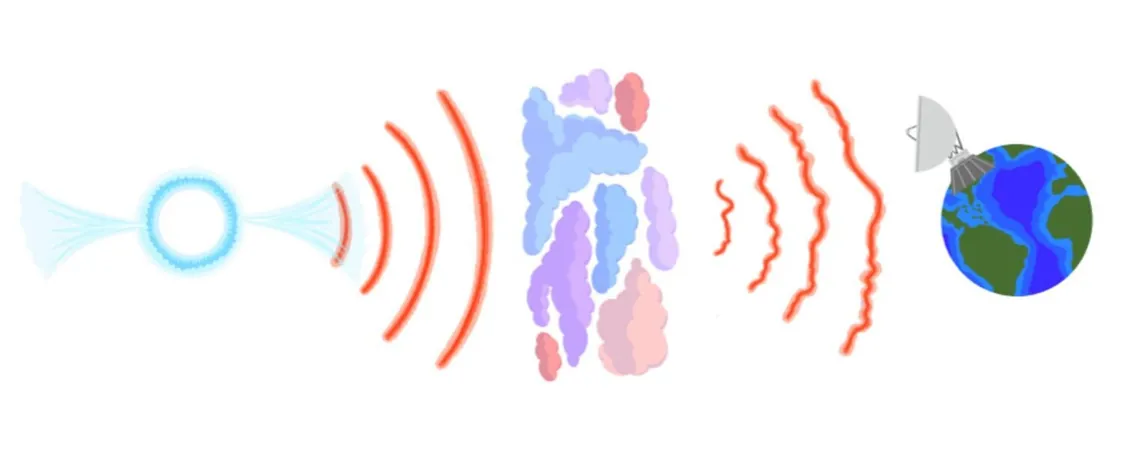
Revolutionary Study Reveals How Pulsar Signals Are Distorted in Space – What This Means for Our Understanding of the Universe!
2024-11-26
Author: Emma
Groundbreaking Research from the SETI Institute
A groundbreaking study led by Dr. Sofia Sheikh from the SETI Institute unveils critical insights into the way pulsar signals—remnants of massive stars—distort as they traverse the vast expanses of space. This research, published in The Astrophysical Journal, stems from a compelling collaboration of undergraduate researchers involved in the Pulsar Search Collaboratory at Penn State University.
Empowering Future Scientists
This initiative, originally devised by Maura McLaughlin, Eberly Distinguished Professor of Physics and Astronomy at West Virginia University, aims to empower high school students and undergraduates in the realm of pulsar science. With her expertise, the team accessed valuable archival data from the now-defunct Arecibo Observatory, allowing them to explore fascinating patterns in pulsar signal distortions.
Significant Findings in Data Analysis
The students meticulously analyzed scintillation bandwidths for 23 pulsars, unveiling new data for six pulsars that had not been previously examined. Their findings reveal that nearly all observed bandwidths exceeded the predictions made by existing models of the galaxy. This alarming discrepancy points to the urgent need for updating our current interstellar medium (ISM) density models.
Importance of Archived Datasets
Dr. Sheikh emphasizes the importance of these archived datasets, stating, "Even years after the collapse of the Arecibo Observatory, its data continues to unlock critical information that can advance our understanding of the galaxy and enhance our ability to study phenomena like gravitational waves."
Understanding Diffraction in Pulsar Signals
As pulsar signals journey through the ISM—a region filled with gas and dust—they undergo a phenomenon known as "diffractive interstellar scintillation" (DISS). This dazzling effect is similar to the way light refracts in water or how stars twinkle at night, caused by clouds of charged particles in space that make the pulsar light appear to "twinkle" over time and frequency.
Collaborations and Future Research
The paper highlights how collaborations like the NANOGrav Physics Frontiers Center are leveraging pulsar data to explore the gravitational wave background. Such research is essential for understanding the early universe and locating gravitational-wave sources, particularly supermassive black-hole binaries. For accurate measurements of these phenomena, pulsar timing must be incredibly precise. The insights from this study aim to improve our models of DISS distortions, thereby enhancing the precision of projects like NANOGrav.
Modeling Galactic Structures
Interestingly, the findings reveal that models incorporating galactic structures, such as spiral arms, align more closely with the DISS data. However, modeling the Milky Way's structure remains a formidable challenge. It was also noted that models showed accuracy for the pulsars used in development, while predictions for newly discovered pulsars were less reliable, underscoring the continuous need for updated galactic models.
Future Directions in Pulsar Research
As part of the AO327 survey from Arecibo, this pilot study lays the groundwork for future inquiries in pulsar scintillation and gravitational waves. The research team intends to expand their study to include more recently discovered pulsars, paving the way for more accurate ISM density models applicable to pulsar timing arrays such as NANOGrav.
Collaborative Contributions
This collaborative research effort includes contributions from scientists at the SETI Institute, Penn State, and the NANOGrav Group at West Virginia University. Among the contributors are SETI Institute researcher Michael Lam and former researcher Grayce Brown.
Conclusion: A New Era in Pulsar Astronomy
In summary, this pivotal research not only opens new doors in pulsar astronomy but also significantly enhances our understanding of cosmic phenomena. The implications of these findings are bound to reverberate through the fields of astrophysics and cosmology, as we strive to unravel the mysteries of the universe!









 Brasil (PT)
Brasil (PT)
 Canada (EN)
Canada (EN)
 Chile (ES)
Chile (ES)
 España (ES)
España (ES)
 France (FR)
France (FR)
 Hong Kong (EN)
Hong Kong (EN)
 Italia (IT)
Italia (IT)
 日本 (JA)
日本 (JA)
 Magyarország (HU)
Magyarország (HU)
 Norge (NO)
Norge (NO)
 Polska (PL)
Polska (PL)
 Schweiz (DE)
Schweiz (DE)
 Singapore (EN)
Singapore (EN)
 Sverige (SV)
Sverige (SV)
 Suomi (FI)
Suomi (FI)
 Türkiye (TR)
Türkiye (TR)